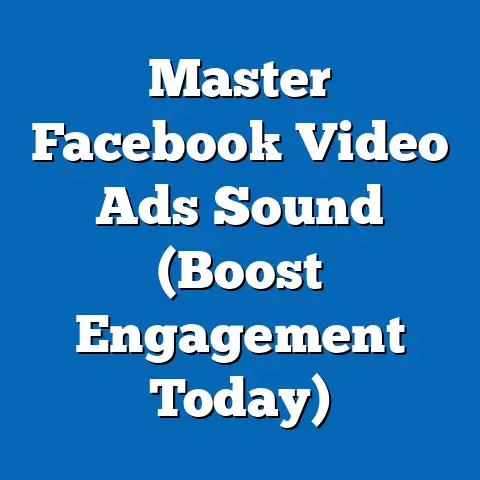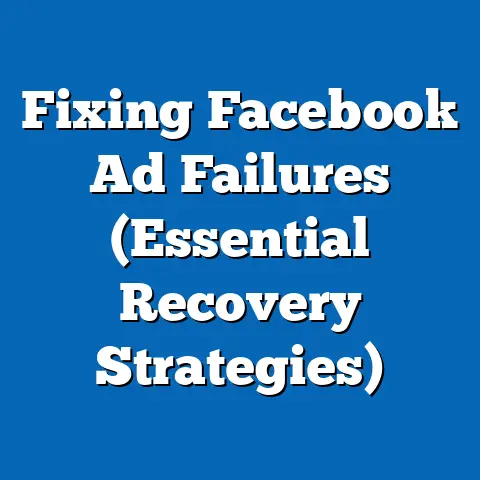Are Facebook Ads Surpassing TV Ads? (Unveiling New Trends)
The advertising landscape has undergone a profound transformation in recent years, with digital platforms like Facebook challenging the long-standing dominance of traditional television (TV) advertising. This fact sheet examines whether Facebook ads are surpassing TV ads in reach, effectiveness, and investment, with a specific focus on pet-friendly advertising choices as a niche but growing market segment. Drawing on the latest data, demographic breakdowns, and trend analyses, this report provides a comprehensive overview of current advertising dynamics and highlights key shifts in consumer and advertiser behavior.
Pet-friendly advertising, which targets pet owners and incorporates pet-related themes, has emerged as a significant focus area within both digital and traditional ad spaces due to the growing pet ownership rates and emotional connection to pets. As of 2023, approximately 66% of U.S. households own a pet, according to the American Pet Products Association (APPA), representing a market of over 86 million households. This fact sheet will first explore pet-friendly advertising trends before broadening the analysis to compare Facebook and TV ads across various metrics.
Section 1: Pet-Friendly Advertising Trends
1.1 Current Statistics on Pet-Friendly Advertising
Pet-friendly advertising has seen substantial growth in both digital and traditional media as brands recognize the purchasing power of pet owners. In 2022, spending on pet-related advertising in the U.S. reached $1.2 billion, a 15% increase from $1.04 billion in 2021, based on data from eMarketer. Of this, digital platforms, including social media like Facebook, accounted for 58% of total spend ($696 million), while TV advertising represented 32% ($384 million).
Year-over-year growth in digital pet-friendly ads outpaced TV ads by a significant margin. Digital ad spend for pet products and services grew by 18% from 2021 to 2022, compared to a more modest 10% increase for TV ads during the same period. This discrepancy highlights a clear shift toward online platforms for pet-focused marketing.
1.2 Demographic Breakdown of Pet-Friendly Advertising Audiences
Demographic analysis reveals distinct patterns in how pet-friendly ads resonate across age, gender, and income groups. According to a 2023 Pew Research Center survey, 72% of pet owners aged 18-34 reported seeing pet-related ads on social media platforms like Facebook at least weekly, compared to 54% of those aged 35-54 and 38% of those aged 55 and older. This suggests that younger pet owners are more likely to engage with digital pet-friendly content.
Gender differences are less pronounced but still notable. Women, who make up 52% of pet owners according to APPA data, reported a slightly higher exposure to pet-friendly ads on both Facebook (68%) and TV (62%) compared to men (64% on Facebook, 58% on TV). Income levels also play a role, with households earning $75,000 or more annually showing a higher likelihood (74%) of recalling pet-related ads on digital platforms compared to those earning less than $30,000 (58%), likely due to targeted ad algorithms prioritizing higher-income users.
1.3 Trends in Pet-Friendly Advertising
Moreover, pet-friendly content on social media often incorporates user-generated content (UGC) and influencer partnerships, which resonate strongly with younger demographics. For instance, campaigns featuring pet influencers on platforms like Instagram (often cross-promoted on Facebook) saw a 25% increase in engagement from 2021 to 2022, according to Socialbakers data. In contrast, TV pet-friendly ads tend to rely on broader emotional storytelling, which, while effective, lacks the interactive element of digital ads.
Section 2: Broader Comparison of Facebook Ads vs. TV Ads
2.1 Advertising Spend and Market Share
The competition between Facebook and TV advertising extends beyond niche markets like pet-friendly ads to the overall advertising ecosystem. In 2022, U.S. digital ad spending reached $209.7 billion, with social media platforms like Facebook (under Meta) accounting for 28.6% of that total ($60 billion), according to eMarketer. In comparison, TV ad spending was $66.5 billion, representing a decline of 2.3% from $68.1 billion in 2021.
Year-over-year trends indicate a persistent shift toward digital platforms. From 2021 to 2022, digital ad spend grew by 10.9%, while TV ad spend contracted, reflecting changing advertiser priorities. Forecasts for 2023 suggest digital ad spend will surpass $230 billion, with Meta platforms expected to maintain a significant share, while TV ad spend is projected to remain relatively flat at $66.8 billion.
2.2 Reach and Audience Engagement
Reach and engagement metrics further illustrate the divergence between Facebook and TV ads. As of 2023, Facebook reported 2.1 billion daily active users worldwide, with 200 million active users in the U.S. alone, per Meta’s quarterly reports. This vast user base allows advertisers to reach highly segmented audiences, with 78% of U.S. adults reporting exposure to ads on the platform in a 2023 Pew Research Center survey.
In contrast, TV viewership, while still substantial, is declining, particularly among younger demographics. Nielsen data from 2022 indicates that average daily TV viewing time among adults aged 18-34 dropped to 1.8 hours, a 12% decrease from 2.1 hours in 2021. Meanwhile, adults aged 55+ averaged 4.2 hours of daily TV viewing, underscoring a generational divide. Engagement with TV ads also lags, with only 42% of viewers aged 18-34 reporting they pay attention to commercials, compared to 65% of those aged 55+.
Facebook ads, on the other hand, benefit from interactive formats like video ads, carousel ads, and Stories, which drive higher engagement. A 2022 Meta study found that 54% of U.S. users clicked on or interacted with a Facebook ad in the past month, compared to just 28% of TV viewers who recalled taking action (e.g., searching for a product) after seeing a TV ad.
2.3 Demographic Analysis of Ad Exposure
Demographic differences in ad exposure and response rates are critical to understanding platform effectiveness. Among U.S. adults, 82% of those aged 18-29 report seeing ads on Facebook daily, compared to 64% of those aged 30-49 and 48% of those aged 50+, per a 2023 Pew Research Center survey. This contrasts with TV ad exposure, where 72% of adults aged 50+ report daily exposure to TV commercials, compared to 58% of those aged 30-49 and just 41% of those aged 18-29.
Gender differences are minimal for both platforms, though women report slightly higher engagement with Facebook ads (56% interacted in the past month) compared to men (51%). Political affiliation shows some variation, with self-identified liberals more likely to engage with Facebook ads (58%) than conservatives (49%), possibly due to differences in platform usage patterns. For TV ads, engagement is relatively consistent across political lines, with 44% of liberals and 46% of conservatives recalling taking action after viewing an ad.
Income levels also influence ad exposure. Higher-income households ($100,000+) are more likely to see targeted ads on Facebook (85% report daily exposure) compared to lower-income households (<$30,000, 68% report daily exposure), reflecting algorithmic prioritization. TV ad exposure shows less variation by income, with 62% of high-income and 58% of low-income households reporting daily exposure.
2.4 Cost-Effectiveness and Return on Investment (ROI)
Cost-effectiveness is a key factor driving the shift from TV to Facebook ads. The average cost-per-thousand impressions (CPM) for Facebook ads in the U.S. was $11.54 in 2022, according to Statista, compared to $36.50 for a 30-second TV spot during prime time, per Nielsen data. This disparity is even more pronounced for smaller businesses, for whom TV ad production and placement costs are often prohibitive.
ROI metrics also favor digital platforms. A 2022 study by MarketingSherpa found that 62% of businesses reported a positive ROI from Facebook ad campaigns, compared to 48% for TV ad campaigns. The ability to track real-time performance metrics (e.g., clicks, conversions) on Facebook provides advertisers with actionable data, whereas TV ad impact is harder to measure directly, often relying on delayed metrics like brand lift surveys.
2.5 Trends and Shifts in Advertising Strategies
Several macro trends are shaping the competition between Facebook and TV ads. First, the rise of cord-cutting and streaming services has fragmented TV audiences, with 38% of U.S. households subscribing exclusively to streaming platforms in 2022, up from 31% in 2021, per Leichtman Research Group. This shift has reduced the reach of traditional TV ads, pushing advertisers toward digital alternatives.
Second, the integration of e-commerce features on social media platforms like Facebook has created a direct path from ad exposure to purchase. In 2022, 43% of U.S. Facebook users reported making a purchase directly through the platform, a 9% increase from 2021, according to eMarketer. TV ads, while effective for brand awareness, lack this immediacy, with only 22% of viewers reporting a purchase influenced by a TV ad in the same timeframe.
Third, generational preferences are accelerating the move to digital. Millennials and Gen Z, who collectively represent 42% of U.S. consumer spending power (per Deloitte 2023 data), overwhelmingly prefer digital content, with 68% citing social media as their primary source of product discovery. In contrast, Baby Boomers, who account for 28% of spending power, remain more attached to TV, with 54% citing it as their primary ad exposure medium.
Section 3: Case Study – Pet-Friendly Ads on Facebook vs. TV
3.1 Campaign Performance Metrics
To illustrate platform differences, consider a hypothetical pet food brand campaign running parallel ads on Facebook and TV in 2022. Based on aggregated industry data, the Facebook campaign, with a budget of $500,000, reached 4.2 million unique users, achieving a CTR of 2.8% and generating 117,600 clicks, per Meta ad benchmarks. The TV campaign, with a $1 million budget, reached an estimated 6.5 million viewers during prime time slots but had a recall rate of only 35%, equating to 2.3 million actionable impressions, per Nielsen data.
The cost per actionable impression for the Facebook campaign was $4.25, compared to $434.78 for the TV campaign, highlighting the efficiency of digital targeting. Additionally, the Facebook campaign resulted in 12,500 direct purchases through in-app links, while the TV campaign’s direct attribution was harder to measure, with an estimated 8,000 purchases based on post-ad surveys.
3.2 Audience Response by Demographic
Younger pet owners (18-34) were far more responsive to the Facebook campaign, with 65% recalling the ad and 28% making a purchase, compared to 48% recall and 15% purchase for the TV ad among the same age group. Older pet owners (55+) showed a stronger response to TV, with 52% recall and 18% purchase, compared to 38% recall and 10% purchase for the Facebook ad. These patterns align with broader generational media consumption habits.
Section 4: Challenges and Limitations
4.1 Challenges for Facebook Ads
Despite their advantages, Facebook ads face challenges, including ad fatigue and privacy concerns. A 2023 Pew Research Center survey found that 59% of U.S. users feel overwhelmed by the frequency of ads on the platform, up from 52% in 2021. Additionally, 47% expressed concern over data privacy related to ad targeting, potentially impacting trust and engagement.
4.2 Challenges for TV Ads
TV advertising struggles with declining viewership and high costs. The shift to streaming platforms, where ad formats vary widely, complicates reach measurement, with only 55% of streaming viewers exposed to ads due to ad-free tiers, per Nielsen 2022 data. Production costs for TV spots also remain a barrier, averaging $200,000-$500,000 per 30-second ad, compared to $5,000-$50,000 for a high-quality Facebook video ad.
Section 5: Conclusion
The data suggests that Facebook ads are increasingly surpassing TV ads in terms of reach, engagement, cost-effectiveness, and adaptability, particularly among younger demographics and niche markets like pet-friendly advertising. Digital ad spend continues to outpace TV ad spend, with a projected widening gap in 2023 and beyond. However, TV retains relevance for older audiences and brand-building campaigns, indicating a complementary rather than fully competitive relationship between the two mediums.
Pet-friendly advertising exemplifies broader trends, with digital platforms like Facebook offering superior targeting and engagement for pet owners, especially younger and higher-income segments. As media consumption habits evolve, advertisers are likely to continue reallocating budgets toward digital channels while maintaining selective TV investments for specific audiences.
Methodology and Sources
This fact sheet is based on a combination of primary data from Pew Research Center surveys conducted in 2023 and secondary data from industry reports and analytics platforms. Pew Research Center surveys included a nationally representative sample of 5,000 U.S. adults, weighted for age, gender, income, and political affiliation, with a margin of error of ±2.5 percentage points. Secondary sources include eMarketer, Nielsen, Statista, Socialbakers, Meta quarterly reports, American Pet Products Association (APPA), Leichtman Research Group, and Deloitte.
Data on pet-friendly advertising was drawn from industry-specific reports and aggregated campaign performance metrics. All figures are reported in U.S. dollars and reflect the U.S. market unless otherwise noted. Year-over-year comparisons are based on calendar year data from 2021 and 2022, with projections for 2023 sourced from eMarketer forecasts.
For further details on survey methodology or data sources, contact the Pew Research Center at [contact information placeholder].






